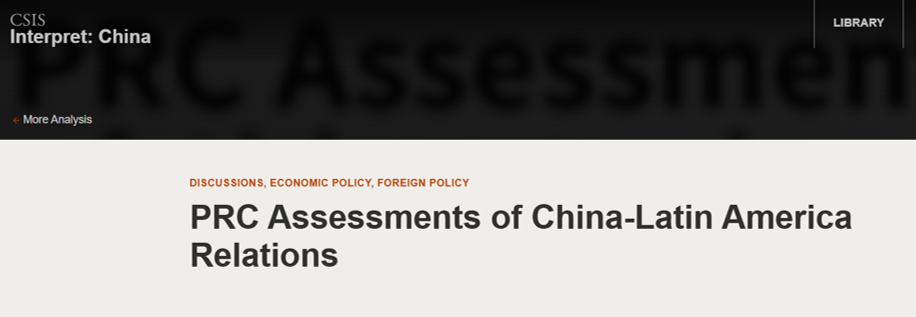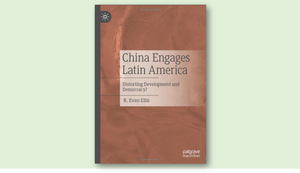
PRC Assessments of China-Latin America Relations
This work represents analysis by Evan Ellis, Parsifal D’Sola Alvarado and Juliana González Jáuregui, of documents written in Chinese by PRC-based scholars, on the subject of PRC-Latin America relations. They were translated by the Center for Strategic and International Studies (CSIS) "Interpret: China" project, and analyzed at a forum by that organization, bringing together the three authors of this work, and other China and Latin America scholars.
Newly translated documents discussed in these analyses include:
- China–Latin America “Belt and Road” Cooperation in the Context of Changes Unseen in a Century by Cao Ting, associate researcher at the Institute of International Studies of Fudan University; and Cheng Yiyang, professor in the Spanish Department of the College of Foreign Languages and Literature of Fudan University.
- China and Latin America’s Joint Construction of the Belt and Road: Progress, Challenges, and Prospects by Lou Yu, assistant researcher at the Institute of Latin American Studies of Chinese Academy of Social Sciences.
- Characteristics, Motivations, and Challenges in the Transformation of China–Latin America Relations by Cui Shoujun, associate professor at the School of International Studies of Renmin University of China and director of the Center for Latin American Studies.
R. Evan Ellis | Parsifal D’Sola Alvarado | Juliana González Jáuregui

R. Evan Ellis. Research Professor, Latin American Studies, U.S. Army War College Strategic Studies Institute
In three translated works by Cao Teng and Cheng Yiyang, Lou Yu, and Cui Shoujun, what topics are not discussed seem to shed more light on Chinese academic thinking toward Latin America than the topics that are.
Notably, all three works reference the Belt and Road Initiative (BRI), suggesting this officially sanctioned framework impacts People’s Republic of China (PRC) thinking beyond merely serving as a public relations slogan during engagement with Latin American and other partners. Notably, however, none of the documents mentions China’s other, newer programs—including the Global Development Initiative, Global Civilization Initiative, and Global Security Initiative—which have been introduced in recent years to complement the BRI and give PRC engagement with the region a more explicitly strategic and political character.
Beyond frameworks, none of these three papers address the security dimension of PRC activities—or other noneconomic concerns that play an increasing role in the discussion of its engagement in the United States and the Americas more broadly. None, for example, discussed PRC arms sales and donations, its training of Latin American military and police officers, its role in military exchanges with and exercises in the region, PRC-based private security companies, or even Chinese space sector engagement.
Other notably absent topics include the recognition of Taiwan by seven Latin American and Caribbean governments (as well as ongoing PRC efforts to change the posture of those governments); Chinese people-to-people exchanges that host politicians, judges, police, journalists, academics, and other strategically important individuals from the region; PRC engagement through multilateral institutions, including both the Community of Latin American and Caribbean States (CELAC) and BRICS; or the use of BRICS, as well as bilateral agreements such as bank swaps and contracts, to promote the yuan as an alternative to the dollar.
The documents also did not include discussion about Western concerns over how the expansion of trade, business relationships, and PRC-based companies and financial institutions in the region have facilitated criminal activities—including the production and sale of fentanyl and its precursors; money laundering; Chinese involvement in the illegal mining value chain; illegal, unreported, and unregulated (IUU) fishing by the Chinese deepwater fleet; wildlife trafficking; and human trafficking in the region involving Chinese mafias and ethnic communities.
The documents notably pay little attention to PRC activities close to the United States in Central America and the Caribbean, despite significant recent political and commercial advances in countries there, particularly in Mexico, Honduras, and Nicaragua. Similarly, areas in which the PRC and its companies have run into commercial problems and political pushback, including with major energy projects in Ecuador and the governments of Jair Bolsonaro in Brazil and Javier Milei in Argentina, are also not discussed. Indeed, there is almost a complete absence of any references to concerns over the performance of Chinese companies in the region, including contractual issues, defects, social conflicts, and environmental concerns associated with their projects and other activities.
It is difficult to assess whether these three works are representative of Chinese government thinking on Latin America beyond the scholarly community, although the authors are consistent with their own English-language work and those of other PRC-based scholars. While the noted omissions may be idiosyncratic, it is more likely that they reflect disincentives within the PRC academic community to write on sensitive topics, particularly in self-critical ways. In the context of growing Chinese hubris accompanying growing Chinese economic and military power during President Xi Jinping’s unprecedented third term, such avoidance of sensitive topics—or any issues that may cast Beijing in a negative light—may have adverse policy consequences for the PRC and its companies. This may contribute to PRC-based government and commercial figures giving too much weight to the real hopes that they will benefit from engagement in the region, missing or underestimating the sources of friction and concern there—and in the United States—that may later cause them problems.

Parsifal D’Sola Alvarado. Founder and Executive Director, Andrés Bello Foundation – China Latin America Research Center
Chinese ties with Latin American and Caribbean (LAC) countries have evolved significantly over the past two decades. What was once largely an economic relationship fueled by the commodity boom of the 2000s has transformed into a web of diverse and complex political and economic exchanges that differ greatly from country to country. However, these intricacies are not reflected in three recent articles by Cui Shoujun, Lou Yu, and Cao Ting and Cheng Yiyang. These articles exemplify the limited scope of Chinese academia in Latin American studies. As with many other recent works in the field, they prioritize alignment with the Peoples Republic of China (PRC) narrative over offering critical, balanced academic analysis.
Notably, these articles are descriptive rather than analytical. They sidestep any discussion of the shortcomings of the Belt and Road Initiative (BRI), which are crucial for a comprehensive understanding of the PRC’s foreign policy in Latin America and the Caribbean. The BRI has yielded mixed results in the region—some projects have been successful, while others have suffered delays, mismanagement, and corruption, leading to backlash from local governments and civil society. In some cases, BRI agreements have catalyzed further bilateral collaboration; in others, they have amounted to little more than political gestures.
Another issue is how the authors frame the role of the United States. They primarily depict U.S. actions in the region as obstacles to PRC-LAC cooperation, focusing narrowly on strategic competition. This perspective neglects decades of U.S.-led aid programs, investment, and institutional support that have significantly shaped regional development. It also overlooks cultural affinities the United States shares with LAC. While the authors emphasize the history of U.S. intervention in the region—an important but not exclusive factor—they fail to account for the multifaceted nature of U.S.-LAC relations, reducing them to a simplistic geopolitical rivalry.
The authors further assume that Latin American countries universally embrace closer ties with China, portraying the region as a passive recipient of Chinese influence. This perspective ignores the diversity of national contexts and the agency of regional governments. With the exceptions of autocracies such as Cuba, Nicaragua, and Venezuela, most countries aim to balance relations with China, the United States, and other partners rather than align with any particular bloc or power. Hesitation to engage with China often stems not only from U.S. pressure but also from legitimate concerns about debt, sovereignty, deindustrialization, lack of transparency, and other issues.
A clear bias also emerges in favor of leftist governments, which the authors portray as more cooperative with China, while right-leaning governments are depicted as obstacles, often attributed to U.S. influence. This reductionist view overlooks the shared challenges both left- and right-leaning governments face when engaging with the PRC or any other major external actor, including the United States.
The articles’ exclusive reliance on PRC official sources further limits their analysis. When compiling official trade data, for example, China often aggregates financial indicators without distinguishing between loans and foreign direct investment, making it difficult to assess the true nature of its economic involvement in the region.
Despite these shortcomings, the articles offer valuable insights into China’s strategic interests in LAC, which can help inform regional decisionmaking and highlight areas for further academic research. First, they underscore that the United States remains a central variable in Chinese foreign policy, viewed predominantly through a geopolitical lens. Second, they present the BRI as a cornerstone of China’s engagement, purposefully framed as a solution to the region’s challenges, from infrastructure deficits to economic diversification.
The authors also highlight China’s emphasis on securing access to natural resources and agricultural products, something that can be understood as part of its strategy to stabilize supply chains and ensure food security. Similarly, the PRC’s focus on infrastructure projects reflects its goal of integrating deeply into the region’s economic systems, positioning itself as indispensable in sectors such as transportation, electrical grids, and trade connectivity.
Additionally, the articles shed light on the PRC’s soft-power initiatives, such as Confucius Institutes, academic exchanges, and cultural programs, which aim to foster goodwill and counter skepticism about its growing influence. Notably, the articles suggest a growing awareness within China of LAC’s diverse and fluctuating political landscape, a factor that could translate into improved risk assessment by the PRC. Between the lines, there is also an acknowledgment that Chinese companies need to address their poor track record in adhering to local LAC regulations.
While the articles are primarily descriptive, they do serve as valuable indicators of China’s policy priorities. They reveal a multifaceted approach aimed at deepening economic ties, advancing geopolitical objectives, and fostering cultural connections, all while navigating the challenges of U.S.-China competition in the region.

Juliana González Jáuregui. Researcher, FLACSO Argentina
China’s growing presence in Latin America, particularly through the Belt and Road Initiative (BRI), has become an essential topic for analysis. Scholars such as Cao Ting, Cheng Yiyang, Lou Yu, and Cui Shoujun have explored the economic and geopolitical dimensions of China’s involvement in the region. Yet while their analyses provide valuable insights into China’s engagement, they often overlook critical social, environmental, and political factors that could shape the long-term outcomes of these interactions.
Cao Ting and Cheng Yiyang frame the BRI as a mechanism for fostering economic cooperation and reducing regional inequalities through infrastructure development. However, their paper insufficiently addresses the social and environmental consequences of these Chinese investments, particularly in sectors such as critical minerals. These projects have raised significant concerns, including Indigenous resistance, environmental degradation, and non-compliance with local regulations. By not fully considering these tensions, this analysis underestimates the potential for social and ecological conflicts that could undermine the sustainability of China’s initiatives in Latin America.
Similarly, Lou Yu emphasizes the BRI as a pathway to multilateralism and high-quality development. However, this perspective assumes a homogeneity among Latin American countries in their political orientation and engagement with China. For example, Lou’s work focuses predominantly on partnerships with left-wing governments, overlooking the potential challenges of emerging right-wing leaders such as Argentina’s Javier Milei, whose policies introduce new dynamics. Furthermore, this analysis does not adequately consider the role of subnational governments, civil society, and nongovernmental organizations. These actors often play a decisive role in shaping the implementation of foreign investments, either facilitating or hindering China’s plans.
Cui Shoujun’s work highlights the economic complementarity between China and Latin America, focusing on trade and investment flows. However, he also downplays the socio-environmental tensions associated with these investments. For instance, the extraction of critical minerals has frequently sparked local resistance due to concerns over environmental impacts and the displacement of Indigenous communities. Additionally, Cui’s emphasis on promoting economic cooperation and maximizing trade opportunities overlooks the risks of resource dependence and fails to explore strategies for fostering development. Issues such as technology transfer, value –chain integration, and long-term economic diversification remain underexplored, limiting the article’s applicability to policy recommendations.
These gaps in the existing literature reveal a broader trend of prioritizing economic and geopolitical considerations over the social, environmental, and political complexities that shape Sino–Latin American relations. Without a more nuanced understanding of these factors, there is a risk of misalignment between China’s expectations and the realities on the ground in Latin America.
For external actors such as the United States, these analyses provide a useful foundation for understanding China’s involvement in the region. However, they also highlight the need to address broader implications beyond economic metrics. As critical minerals and renewable energy technologies become central to China’s and the United States’ global strategies, understanding the interplay between economic, social, and environmental factors becomes crucial for shaping effective policies. This is particularly important because China presents its investments as mutually beneficial while the United States often perceives them as a strategic challenge.
While the cited experts offer valuable perspectives on China’s engagement in Latin America, their analyses would benefit from incorporating a more comprehensive approach to these interactions’ social, environmental, and political dimensions. By considering the risks of resource dependence, the opportunities for technology transfer, and the importance of inclusive governance, China and Latin American countries can better navigate the challenges of their partnerships. For the United States, a deeper understanding of these dynamics is also essential to engaging effectively with the region and responding to the evolving landscape of Sino–Latin American relations.
R. Evan Ellis



